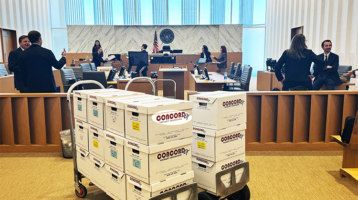[mp_row]
[mp_span col=”12″]
2013 E-Discovery Year in Review: Part 2
A quiet year in the courts as the profession appears to accept that EDD is here to stay.
By Cecil Lynn & Lauren Schwartzreich All Articles
Law Technology News
Call CONCORD dt today … (800) 246-7881
January 6, 2014
Last year was surprisingly quiet on the electronic data discovery front. No earth-shattering opinions, no imprisoned spoliators, and barely a whimper from reported decisions related to parties’ chosen form of production. Perhaps the bench and bar are getting more sophisticated and technology savvy. Or perhaps the courts implicitly recognized the current state of flux, what with the proposed amendments to the Federal Rules of Civil Procedure that specifically address EDD. Or possibly, the industry is evolving from what was once considered cutting-edge and novel to what is emerging as best practices.
Cooperation
In years past, cooperation and EDD competence have been singled out by judges. This year was no exception. In U.S. Bank National Association v. PHL Variable Insurance Co., No. 12-CV-6811 (S.D.N.Y. Apr. 22, 2013), U.S. Magistrate Judge James Francis IV urged litigants to take seriously their cooperation obligation to reduce the number of disputes that could be resolved without court intervention. This is not an unexpected charge given that the U.S. District Court for the Southern District of New York implemented a pilot program two years ago to increase awareness and cooperation in EDD. In 2013, the Eastern District of Michigan followed suit with a “Meet and Confer Checklist and Model Order Related to the Discovery of Electronically Stored Information.”
Proportionality
Courts have placed an increased and more immediate focus on the parties’ meaningful efforts to streamline discovery and consider the cost and burdens associated with their discovery requests. See, e.g., In re Morgan Stanley Mortgage Pass-Through Certificates Litig., No. 09-CV-02137 (S.D.N.Y. Sept. 11, 2013).
In Morgan Stanley, U.S. Magistrate Judge Sarah Netburn was called upon to resolve the parties’ impasse related to the number of custodians whose electronic data should be searched and the relevant time period for the search. Before ruling, Netburn walked the parties through the proportionality considerations of Federal Rule of Civil Procedure 1 (which sets the tone for all litigation directing the rules to be administered with an eye towards a “just, speedy and inexpensive” resolution of every case) and 26(b)(2)(C) (which states a court “must” limit discovery that is unreasonably duplicative, more easily obtained from another source, or is burdensome or expensive when compared to its likely benefit).
Applying these principles, Netburn reduced plaintiffs’ requested 80 discovery custodians to 34, finding that the burden to the defendant in terms of both reviewing duplicative material and reviewing false search hits would not be insignificant given the scope of the issues involved and the parties’ agreed-upon list of search terms that spanned 1,600 pages and contained more than 30,000 terms.
Likewise, in Connecticut General Life Insurance v. Earl Scheib, Inc., No. 11-CV-0788 (S.D. Cal. Feb. 6, 2013), U.S. Magistrate Judge William Gallo underscored that, while data accessibility is an important factor in determining whether a discovery request places an undue burden on the producing party, an equal (if not greater) consideration should be given to the cost of the discovery when compared with its benefit in litigation. Accordingly, Gallo denied plaintiff’s motion to compel discovery of 219 gigabytes of data from 19 different email accounts that would have cost the defendant more than $121,000 to collect, search and produce. Gallo reasoned that “if Plaintiff believes that this information is important to its case, then Plaintiff can perform its own cost-benefit analysis and determine whether it wants to fund the discovery.”
Cost Shifting
In the past few years, courts have provided much-needed guidance on EDD cost shifting and cost allocation. In 2013, courts focused not only on cost shifting between parties, but also on how to allocate ESI expenses incurred by non-parties. See, e.g., In re Subpoena of Am. Nurses Assoc., No. AW-11-2837 (D. Md. Feb. 13, 2013) (confirming order that The Fair Labor Standards Act of 1938 plaintiffs pay the $250,000-plus EDD costs related to its subpoena on a non-interested third party).
Even when the non-party and a party share an interest in the subject matter of litigation—a factor that weighs against cost shifting—one court held that the sheer volume of discovery can tip the balance in favor of shifting EDD-related expenses. In Maximum Human Performance, LLC v. Sigma-tau HealthScience, LLC, No. 12-CV-6526 (D.N.J. Aug. 27, 2013) (unpublished). Magistrate Judge Steve Mannion found that partial cost shifting was appropriate where the defendant sought the production of voluminous EDD from a third party, Vitaquest International, related to its manufacture of a dietary supplement containing defendant’s product. Vitaquest conceded that it had a longstanding relationship with the plaintiff and that it had the financial resources to pay for the discovery. Nonetheless, Mannion ordered the defendant to reimburse Vitaquest for one-third of the vendor costs to harvest the ESI.
Cost Recovery
There was also a significant increase in the number of reported cases dealing with prevailing parties’ recovery of EDD-related expenses. Generally, a prevailing party is entitled to recover costs, including “fees for exemplification and the cost of making copies of any materials where the copies are necessarily obtained for use in the case.” See FRCP 54(d) and 28 U.S.C. § 1920(4).
While there is no consensus among the courts as to what EDD costs fall within the exemplification category, the Fourth Circuit closely followed the Third Circuit’s 2012 ruling in Race Tires that limited cost recovery to the conversion of native files to .tiff and the scanning of documents to create digital duplicates. See Country Vintner of N.C., LLC v. E. & J. Gallo Winery, Inc., No. 12-2074 (4th Cir. Apr. 29, 2013) citing Race Tires Am. Inc. v. Hoosier Racing Tire Corp., 674 F.3d 158 (3d Cir.), cert. denied, 133 S. Ct. 233 (2012)).
See also Phillips v. Wellpoint, No. 3:10-cv-00357 (S.D. Ill. May 16, 2013) (holding the conversion of documents into .tiff images is recoverable).
Yet, other jurisdictions interpret U.S. Code title 28, section 1920(4) more broadly and permit the recovery of a wide range of EDD-related expenses. See, e.g., United States v. Integrated Coast Guard Sys., LLC, No. 3:06-cv-1792-O (N.D. Tex. Mar. 27, 2013) (holding entire cost of electronic production recoverable). Amana Society, Inc. v. Excel Engineering, Inc., No. 10-CV-168 (N.D. Iowa Feb. 4, 2013).
Predictive Coding
In 2012, the uniform prediction was that more parties and courts would be drawn to technology-assisted document review (aka predictive coding) in lieu of traditional search terms and human review. But the number of 2013 reported court cases discussing the use of predictive coding were in single digits and the majority of those cases did not involve a party’s actual use of the technology. See, e.g., Chevron Corp. v. Donziger, No. 11-CIV-0691 (S.D.N.Y. Mar. 15, 2013) (questioning whether predictive coding could be used to “reduce the burden and effort” required to comply with a subpoena); Hinterberger v. Catholic Health Sys., No. 08-CV-380S (W.D.N.Y. May 21, 2013) (deeming moot plaintiff’s request to force defendant to meet and confer regarding the implementation and use of predictive coding software because the parties agreed to confer).
If anything, the 2013 case law underscored that traditional keywords and document review may appropriately be used in conjunction with technology-assisted review. See In re Biomet M2a Magnum Hip Implant Products Liability Litig., No. 3:12-MD-2391 (N.D. Ind. Apr. 18, 2013) (rejecting plaintiffs’ call for a “do-over” and finding defendants’ use of both search terms and predictive coding to be reasonable and proportionate).
While 2013 did not produce any “bombshell” e-discovery opinions, it did underscore that EDD standards are far from settled, including because of variances among circuits (and oftentimes individual judges). Whether the proposed amendments to the FRCP that address EDD will bring more uniformity to the field remains an open issue for 2014.
We will also have to wait and see whether the courts will resolve splits of authorities and build an even stronger foundation for consistency upon which all litigants can rely in the year to come.
[/mp_span]
[/mp_row]
Call CONCORD dt today … (800) 246-7881
Error: Contact form not found.


